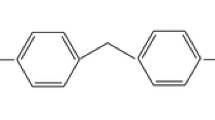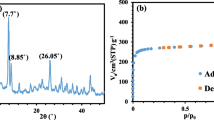Abstract
The effects of dynamic vulcanization systems including sulfur, peroxide, and sulfur/peroxide mixed vulcanization were investigated for dynamically-vulcanized blends of polylactic acid (PLA) and natural rubber (NR) at the PLA/NR ratio of 85/15. For the sulfur system, the CV sub-system (CV1), which used much lower accelerator (TBBS) content than the EV sub-system, rendered higher impact strength and higher %crystallinity. When compared to the peroxide system using DCP as a curative, the impact strength of CV1 sample was almost 4 times lower than the peroxide-cured sample even though their rubber domain sizes and size distributions were comparable. Interestingly, the highest impact strength which was almost 6 times that of the unmodified PLA/NR was achieved when using the mixed sulfur/peroxide system at the CV1/peroxide ratio of 30:70 (S30/DCP70). The lower impact strength of the sulfur-cured system (CV1) compared to those of the peroxide and the mixed-vulcanization systems was potentially due to its significantly higher % crystallinity.

















Similar content being viewed by others
References
Nagarajan V, Mohanty AK, Misra M (2016) Perspective on polylactic acid (PLA) based sustainable materials for durable applications: Focus on toughness and heat resistance. ACS Sustainable Chemistry & Engineering 4(6):2899–2916
Babu RR, Naskar K (2010) Recent Developments on Thermoplastic Elastomers by Dynamic Vulcanization. Advanced Rubber Composites 239:219–247
Rajeshbabu R, Gohs U, Naskar K, Mondal M, Wagenknecht U, Heinrich G (2012) Electron-Induced Reactive Processing of Poly (propylene)/Ethylene–Octene Copolymer Blends: A Novel Route to Prepare Thermoplastic Vulcanizates. Macromol Mater Eng 297(7):659–669
Mondal M, Gohs U, Wagenknecht U, Heinrich G (2013) Polypropylene/natural rubber thermoplastic vulcanizates by eco-friendly and sustainable electron induced reactive processing. Radiat Phys Chem 88:74–81
Wu H, Tian M, Zhang L, Tian H, Wu Y, Ning N, Hu GH (2016) Effect of rubber nanoparticle agglomeration on properties of thermoplastic vulcanizates during dynamic vulcanization. Polymers 8(4):127
Taksapattanakul K, Tulyapitak T, Phinyocheep P, Ruamcharoen P, Ruamcharoen J, Lagarde F, Edely M, Daniel P (2017) Raman investigation of thermoplastic vulcanizates based on hydrogenated natural rubber/polypropylene blends. Polym Testing 57:107–114
Shi M, Zhang D, Zhu J, Shi Y, Sun J, Ji Y (2019) Morphology, crystallization, and thermal and mechanical properties of dynamic vulcanization EPDM/PP thermoplastic elastomer. J Thermoplast Compos Mater 32(7):922–935
Riahi F, Benachour D, Douibi A (2004) Dynamically vulcanized thermoplastic elastomer blends of natural rubber and polypropylene. Int J Polym Mater 53(2):143–156
Thitithammawong A, Nakason C, Sahakaro K, Noordermeer J (2007) Effect of different types of peroxides on rheological, mechanical, and morphological properties of thermoplastic vulcanizates based on natural rubber/polypropylene blends. Polym Testing 26(4):537–546
Thitithammawong A, Uthaipan N, Rungvichaniwat A (2012) The effect of the ratios of sulfur to peroxide in mixed vulcanization systems on the properties of dynamic vulcanized natural rubber and polypropylene blends. Songklanakarin J Sci Technol 34(6):653–662
Nakason C, Nuansomsri K, Kaesaman A, Kiatkamjornwong S (2006) Dynamic vulcanization of natural rubber/high-density polyethylene blends: effect of compatibilization, blend ratio and curing system. Polym Testing 25(6):782–796
Kalkornsurapranee E, Nakason C, Kummerlöwe C, Vennemann N (2013) Development and preparation of high-performance thermoplastic vulcanizates based on blends of natural rubber and thermoplastic polyurethanes. J Appl Polym Sci 128(4):2358–2367
Klinkajorn J, Tanrattanakul V (2020) The effect of epoxide content on compatibility of poly (lactic acid)/epoxidized natural rubber blends. J Appl Polym Sci 137(34):48996
Meekum U, Khiansanoi A (2018) PLA and two components silicon rubber blends aiming for frozen foods packaging applications. Results in physics 8:79–88
Talbamrung T, Kasemsook C, Sangtean W, Wachirahuttapong S, Thongpin C (2016) Effect of peroxide and organoclay on thermal and mechanical properties of PLA in PLA/NBR melted blend. Energy Procedia 89:274–281
Shakouri Z, Nazockdast H, Ghari HS (2020) Effect of the geometry of cellulose nanocrystals on morphology and mechanical performance of dynamically vulcanized PLA/PU blend. Cellulose 27(1):215–231
Zhang L, Hua J, Wang Z (2019) Dynamically vulcanized polylactide/nitrile butadiene rubber blends with continuous cross-linked rubber phase. J Polym Res 26(1):11
Liu L, Hou J, Wang L, Zhang J, Duan Y (2016) Role of Dicumyl Peroxide on Toughening PLLA via dynamic vulcanization. Ind Eng Chem Res 55(37):9907–9914
Pattamaprom C, Chareonsalung W, Teerawattananon C, Ausopron S, Prachayawasin P, Van PP (2016) Improvement in impact resistance of polylactic acid by masticated and compatibilized natural rubber. Iran Polym J 25(2):169–178
Jaratrotkamjorn R, Khaokong C, Tanrattanakul V (2012) Toughness enhancement of poly (lactic acid) by melt blending with natural rubber. J Appl Polym Sci 124(6):5027–5036
Chen Y, Yuan D, Xu C (2014) Dynamically vulcanized biobased polylactide/natural rubber blend material with continuous cross-linked rubber phase. ACS Appl Mater Interfaces 6(6):3811–3816
Yuan D, Chen K, Xu C, Chen Z, Chen Y (2014) Crosslinked bicontinuous biobased PLA/NR blends via dynamic vulcanization using different curing systems. Carbohyd Polym 113:438–445
Si WJ, Yuan WQ, Li YD, Chen YK, Zeng JB (2018) Tailoring toughness of fully biobased poly (lactic acid)/natural rubber blends through dynamic vulcanization. Polym Testing 65:249–255
Yamoum C, Maia J, Magaraphan R (2017) Rheological and thermal behavior of PLA modified by chemical crosslinking in the presence of ethoxylated bisphenol A dimethacrylates. Polym Adv Technol 28(1):102–112
Rytlewski P, Żenkiewicz M, Malinowski R (2011) Influence of dicumyl peroxide content on thermal and mechanical properties of polylactide. Int Polym Proc 26(5):580–586
Coltelli MB, Bronco S, Chinea C (2010) The effect of free radical reactions on structure and properties of poly (lactic acid) (PLA) based blends. Polym Degrad Stab 95(3):332–341
Rigolin TR, Costa LC, Venâncio T, Perlatti B, Bettini SH (2019) The effect of different peroxides on physical and chemical properties of poly (lactic acid) modified with maleic anhydride. Polymer 179:121669
Kruželák J, Sýkora R, Hudec I (2016) Sulphur and peroxide vulcanisation of rubber compounds overview. Chem Pap 70(12):1533–1555
Kruželák J, Sýkora R, Hudec I (2014) Peroxide vulcanization of natural rubber. Part I: effect of temperature and peroxide concentration. J Polym Eng 34(7):617–624
Huang Y, Zhang C, Pan Y, Wang W, Jiang L, Dan Y (2013) Study on the effect of dicumyl peroxide on structure and properties of poly (lactic acid)/natural rubber blend. J Polym Environ 21(2):375–387
Wang Y, Chen K, Xu C, Chen Y (2015) Supertoughened biobased poly (lactic acid)–epoxidized natural rubber thermoplastic vulcanizates: fabrication, co-continuous phase structure, interfacial in situ compatibilization, and toughening mechanism. J Phys Chem B 119(36):12138–12146
Acknowledgments
This work was supported by the Thailand Science Research and Innovation (TSRI) through the Royal Golden Jubilee Ph.D. Program Scholarship [Grant no. PHD/0058/2557] and the research unit funding, Thammasat University.
Author information
Authors and Affiliations
Corresponding author
Additional information
Publisher’s Note
Springer Nature remains neutral with regard to jurisdictional claims in published maps and institutional affiliations.
Rights and permissions
About this article
Cite this article
Chanthot, P., Kaeophimmueang, N., Larpsuriyakul, P. et al. The effect of dynamic vulcanization systems on the mechanical properties and phase morphology of PLA/NR reactive blends. J Polym Res 28, 34 (2021). https://doi.org/10.1007/s10965-020-02364-2
Received:
Accepted:
Published:
DOI: https://doi.org/10.1007/s10965-020-02364-2




